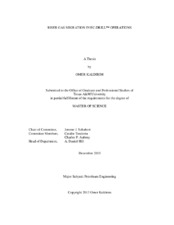| dc.description.abstract | Increased demand for oil and gas pushes producers to develop and enhance methods for exploring deeper reservoirs located in offshore fields. With greater depths comes greater complications, this greater water depth along with other unknown formation factors in conjunction with the high daily rental cost of offshore rigs, equipment and personnel renders performing research and development on a deep water offshore well prohibitively expensive. However, with the occurrence of incidents such as the Macondo in 2010, regulators and operators have been prompted to be more cautious and perform research in offshore drilling operations, to better understand the unknown factors which involve the deepwater conditions.
This thesis investigates riser gas migration while drilling offshore wells using the EC-Drill™ technology. EC-Drill™ is a variation of Dual Gradient Drilling, where two fluid gradients are achieved by controlling the annular mud level in the riser via subsea pumps, voiding the top section to air, forming the two gradients; air in top section and drilling mud for the remaining fluid column, providing dynamic control of the Bottom Hole Pressure and improved drilling and well control capabilities, which reduce costs, non-productive time and create a safer drilling environment. However, one of the issues of voiding the riser to air in the EC-Drill™ is that if a gas kick occurs or gas is drilled, then the gas entering the system will rise to the voided section of the riser creating a combustible mixture of gas and air below the rig floor, leading to devastating results such as equipment damage, losing the well, and even death. These results make it important to understand and mitigate the problem of gas migration. This study provides the design process of the experiment facility in which the gas migration study was performed and the preliminary tests that were done to study gas migration.
The method of elimination that was proposed for the testing facility was called the “top fill technique”, where additional drilling fluid is injected from the top of the riser in the annulus, causing a downward flow motion which is meant to prevent the gas from rising up. The injected drilling fluid is then returned to the rig floor through the EC-Pump mounted on the riser along with the gas. This method requires a priori knowledge of the amount of drilled gas, mud properties, circulation rates, the injection rate and the required downward flow which is obtained through experiments.
To perform the necessary experiments a small-scale simulator was designed at the University Services Building at Texas A&M University, following the guidelines provided by the EC-Drill™ Technology Providers and available literature. The model was scaled to 1/3 of actual riser size and initial tests were done using water to prove the successful design and installation of the equipment. Following this, the scaled model was prepared and calibrated to accommodate clear drilling mud to provide visual study of the gas migration phenomenon. However, due to the limitations of the pump rates and flow meters along with the use of water as a drilling mud, the tests were unsuccessful in fully mitigating the gas migration issue, leading to the need of upgrading the equipment that were used to run the tests. | en |


